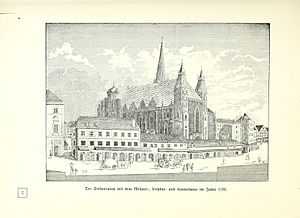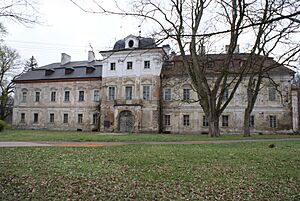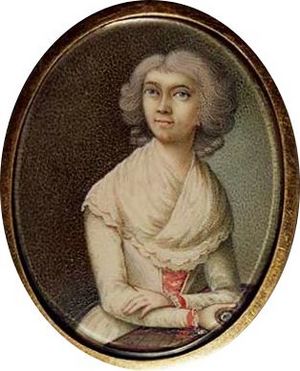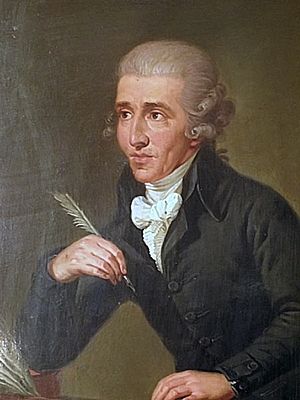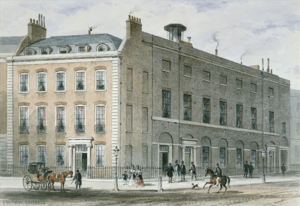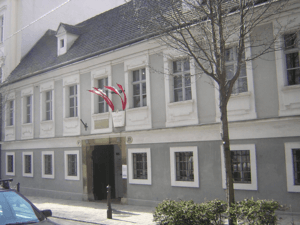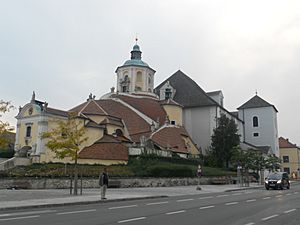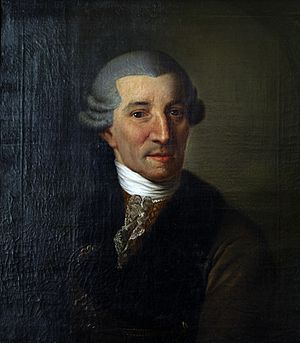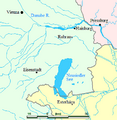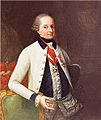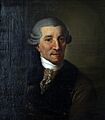Joseph Haydn facts for kids
Franz Joseph Haydn (born March 31, 1732 – died May 31, 1809) was an important Austrian composer from the Classical music period. He helped create and develop types of music like the string quartet and piano trio. Because of his big impact on how music was put together, he is often called the "Father of the Symphony" and the "Father of the String Quartet".
Haydn spent most of his career working as a musician for the very rich Esterházy family at their Eszterháza Castle. For a long time, this job kept him away from other composers and new music trends. This made him, as he once said, "forced to become original." Even though he was isolated, his music became very popular, and he was one of the most famous composers in Europe for many years.
He was a good friend and teacher to Mozart, a teacher to Beethoven, and the older brother of another composer, Michael Haydn.
Contents
Life and Music Career
Early Life and Musical Training
Joseph Haydn was born in Rohrau, a small village in Austria. His father, Mathias Haydn, was a wheel maker and also served as the village mayor. His mother, Maria, used to work as a cook. Neither of his parents could read music, but his father loved folk music and taught himself to play the harp. Haydn later remembered that his family was very musical, and they often sang together with their neighbors.
Haydn's parents noticed he had a special gift for music. They knew he wouldn't get good musical training in Rohrau. So, when Haydn was about six years old, they agreed to let a relative, Johann Matthias Frankh, take him in. Frankh was a schoolmaster and choirmaster in Hainburg. Haydn moved to Hainburg to train as a musician and never lived with his parents again.
Life at Frankh's house was tough for Haydn. He later recalled often being hungry and embarrassed by his dirty clothes. But he started his musical training there. He quickly learned to play both the harpsichord and the violin. He also sang high parts in the church choir.
Haydn's singing was so good that in 1739, Georg Reutter the Younger, the music director at St. Stephen's Cathedral in Vienna, heard him. Reutter was visiting Hainburg looking for new choirboys. Haydn passed his audition. After a few more months of training, he moved to Vienna in 1740. He worked there as a choirboy for the next nine years.
Haydn lived in the Kapellhaus, a building next to the cathedral, with Reutter, his family, and four other choirboys. His younger brother, Michael, joined them after 1745. The choirboys learned Latin and other school subjects, along with singing, violin, and keyboard. Reutter didn't teach Haydn much about music theory or composing, giving him only two lessons. However, St. Stephen's was a major music center, so Haydn learned a lot just by being a professional musician there.
Becoming a Freelance Musician
By 1749, Haydn had grown up and could no longer sing the high choir parts. He then started his career as a freelance musician, meaning he worked for himself and took on different jobs.
At first, Haydn struggled. He worked many different jobs, including teaching music and playing music on the streets. In 1752, he became a valet and accompanist for the Italian composer Nicola Porpora. Haydn later said he learned "the true fundamentals of composition" from Porpora.
While he was a choirboy, Haydn hadn't received much formal training in music theory. To fix this, he studied a book called Gradus ad Parnassum by Johann Joseph Fux, which taught about counterpoint (how different melodies fit together). He also carefully studied the music of Carl Philipp Emanuel Bach, who greatly influenced him. Haydn said that when he first played Bach's keyboard sonatas, he "did not leave my clavier till I played them through."
As his skills grew, Haydn started to become known. He first gained fame as the composer of an opera called Der krumme Teufel ("The Limping Devil"), which was a success in 1753. Between 1754 and 1756, Haydn also worked for the court in Vienna, playing music for special events.
Eventually, Haydn gained support from rich families, which was very important for composers back then. In 1756, Baron Carl Josef Fürnberg hired Haydn to work at his country estate. There, Haydn wrote his first string quartets. He earned a good salary and received free food and a place to live.
Working as a Music Director
Haydn's job title under Count Morzin was Kapellmeister, which means music director. He led the count's small orchestra and wrote his first symphonies for them. In 1760, with a secure job, Haydn got married to Maria Anna Theresia Keller. Their marriage was not a happy one.
Count Morzin soon faced money problems and had to let go of his musicians. But Haydn quickly found a similar job in 1761 with Prince Paul Anton, the head of the extremely wealthy Esterházy family. Haydn started as Vice-Kapellmeister, but he was in charge of most of the Esterházy music. When the old Kapellmeister died in 1766, Haydn became the full Kapellmeister.
As a "house officer" for the Esterházy family, Haydn wore a special uniform and traveled with the family between their palaces. Their main homes were Schloss Esterházy in Eisenstadt and later Eszterháza, a grand new palace built in Hungary. Haydn had many duties, including composing music, leading the orchestra, playing chamber music with his patrons, and putting on opera shows. Even though he had a huge amount of work, this job was a fantastic opportunity for Haydn to develop his music. The Esterházy princes, especially Nikolaus I, loved music and gave Haydn daily access to his own small orchestra. During the nearly 30 years Haydn worked for the Esterházy court, he wrote a huge amount of music, and his style continued to grow.
Much of Haydn's work during this time followed Prince Nikolaus's musical tastes. Around 1765, the prince started learning to play the baryton, a rare instrument similar to a bass viol. Haydn was asked to write music for the prince to play. Over the next ten years, he wrote about 200 pieces for this instrument, including 126 baryton trios. Around 1775, the prince became interested in opera. Opera shows, which used to be rare, became the main focus of music at court. Haydn became the director of the opera company, finding and training singers and leading the performances. He wrote several operas and also wrote new songs to add to operas by other composers.
In 1779, Haydn's contract changed. Before, all his music belonged to the Esterházy family. Now, he was allowed to write for others and sell his music to publishers. Haydn quickly changed what he composed, writing fewer operas and more quartets and symphonies. He worked with many publishers in Austria and other countries. This new contract helped Haydn become famous around the world. By 1790, he was Europe's leading composer, even though he spent his time as a music director in a faraway palace in Hungary. This led to many new string quartets, like the Op. 33, 50, 54/55, and 64 sets. Haydn also wrote music for people outside Austria, such as the Paris symphonies (1785–1786) and the original orchestral version of The Seven Last Words of Christ (1786), which was asked for by a church in Spain.
The remote location of Eszterháza made Haydn feel more and more alone. He missed visiting Vienna because of his friends there. One important friend was Maria Anna von Genzinger, the wife of Prince Nikolaus's doctor in Vienna. They became close friends in 1789. Haydn often wrote to Mrs. Genzinger, telling her how lonely he felt at Esterháza and how happy he was when he could visit her in Vienna. Her early death in 1793 was very sad for Haydn.
Another friend in Vienna was Wolfgang Amadeus Mozart, whom Haydn met around 1784. They sometimes played in string quartets together. Haydn was very impressed with Mozart's music and praised it highly. Mozart also respected Haydn, dedicating a set of six quartets, now called the "Haydn" quartets, to his friend.
Journeys to London
In 1790, Prince Nikolaus died, and his son Anton became the new prince. Anton decided to save money by letting go of most of the court musicians. Haydn kept a small job with Anton, with a lower salary, and also received a pension from Nikolaus. Since Anton didn't need Haydn's services much, he allowed him to travel. Haydn accepted a great offer from Johann Peter Salomon, a German violinist, to visit England and conduct new symphonies.
This was a good choice because Haydn was already very popular in England. After another composer, Johann Christian Bach, died in 1782, Haydn's music was played at almost every concert in London. Haydn's music was widely sold by publishers in London. People had tried to bring Haydn to London since 1782, but his loyalty to Prince Nikolaus had stopped him from going.
After saying goodbye to Mozart and other friends, Haydn left Vienna with Salomon on December 15, 1790. He arrived in Calais just in time to cross the English Channel on New Year's Day of 1791. It was the first time the 58-year-old composer had ever seen the sea. When he arrived in London, Haydn stayed with Salomon and worked in a studio nearby.
This was a very successful time for Haydn. Both his first trip (1791–1792) and a second trip (1794–1795) were hugely successful. Audiences loved Haydn's concerts. He became even more famous and earned a lot of money, which made him financially secure.
Musically, Haydn's visits to England led to some of his most famous works. These include the Surprise, Military, Drumroll, and London symphonies. He also wrote the Rider quartet and the "Gypsy Rondo" piano trio. Even with all this success, the trips had some challenges. For example, his first project, an opera called L'anima del filosofo, was written, but the theater manager couldn't get permission to perform it. Haydn was paid well, but a lot of time was wasted.
Another problem came from a rival orchestra, the Professional Concerts, who hired Haydn's former student Ignaz Pleyel to compete with him. However, Haydn and Pleyel refused to be rivals. They dined together and even played each other's symphonies in their concerts.
The end of Salomon's concert series in June gave Haydn some free time. He spent some time in the countryside and also traveled, notably to Oxford. There, he received an honorary doctorate degree from the university. The symphony played for this occasion, No. 92, is now known as the Oxford Symphony, even though he had written it two years earlier.
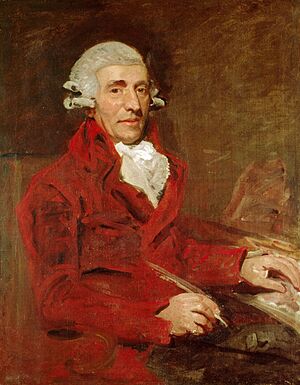
While traveling to London in 1790, Haydn had met the young Ludwig van Beethoven in his hometown of Bonn. When Haydn returned, Beethoven came to Vienna and became Haydn's student until Haydn's second trip to London. Haydn took Beethoven with him to Eisenstadt for the summer and taught him some counterpoint. While in Vienna, Haydn bought a house for himself and his wife in the suburbs and began to fix it up. He also arranged for some of his London symphonies to be performed in local concerts.
By his second trip to England (1794–1795), Haydn was a well-known figure in London's music scene. The 1794 season was dominated by Salomon's group. The concerts included the first performances of Haydn's 99th, 100th, and 101st symphonies. For 1795, Salomon stopped his own series, and Haydn joined forces with the Opera Concerts, led by violinist Giovanni Battista Viotti. These concerts featured Haydn's last three symphonies: 102, 103, and 104. Haydn's final benefit concert at the end of the 1795 season was a huge success and was probably the peak of his English career. Haydn's biographer, Griesinger, wrote that Haydn "considered the days spent in England the happiest of his life. He was everywhere appreciated there; it opened a new world to him."
Years of Fame in Vienna
Haydn returned to Vienna in 1795. Prince Anton had died, and his successor Nikolaus II wanted to bring back the Esterházy music group with Haydn as Kapellmeister again. Haydn took the job part-time. He spent his summers with the Esterházys in Eisenstadt, and over several years, he wrote six masses for them, including the famous Lord Nelson mass in 1798.
By this time, Haydn had become a public figure in Vienna. He spent most of his time at his home in the suburb of Windmühle and wrote music for public performances. Working with his friend and writer Gottfried van Swieten, and with money from van Swieten's music society, he composed his two great oratorios: The Creation (1798) and The Seasons (1801). Both were very popular. Haydn often appeared in public, leading performances of The Creation and The Seasons for charity events. He also composed instrumental music, like the popular Trumpet Concerto, and the last nine of his many string quartets, including the Fifths, Emperor, and Sunrise. Inspired by hearing audiences sing "God Save the King" in London, Haydn wrote a patriotic "Emperor's Hymn" in 1797, called "Gott erhalte Franz den Kaiser" ("God Save Emperor Francis"). This hymn was very successful and became a symbol of Austrian identity for a long time.
During these successful later years, Haydn started to feel the effects of old age and his health went up and down. He had to work hard to finish his last pieces. His last major work, from 1802, was the sixth mass for the Esterházys, the Harmoniemesse.
Retirement, Illness, and Death
By the end of 1803, Haydn's health had gotten worse, and he could no longer compose music. He felt weak, dizzy, couldn't focus, and his legs were painfully swollen.
Haydn's career slowly came to an end. The Esterházy family kept him as Kapellmeister until the very end, but they hired new staff to lead their music group. Haydn's last summer in Eisenstadt was in 1803. His last public appearance as a conductor was a charity performance of The Seven Last Words on December 26, 1803. As he became weaker, he tried to compose but mostly failed. He tried to finish a short mass from his teenage years and his final string quartet. He gave up on the mass in 1805, and the quartet was published with only two movements.
Haydn was well cared for by his servants and received many visitors and public honors in his last years. During his illness, Haydn often found comfort by sitting at the piano and playing his "Emperor's Hymn". A final triumph happened on March 27, 1808, when a performance of The Creation was held in his honor. The very weak composer was carried into the hall in an armchair to the sound of trumpets and drums. He was greeted by Beethoven, Salieri (who led the performance), and other musicians and important people. Haydn was deeply moved but also exhausted and had to leave during the intermission.
Haydn lived for 14 more months. On May 26, he played his "Emperor's Hymn" with unusual energy three times. That same evening, he collapsed and was taken to his deathbed. He died peacefully at his home at 12:40 a.m. on May 31, 1809, at the age of 77. On June 15, a memorial service was held where Mozart's Requiem was performed. Haydn's body was first buried in a local cemetery. In 1820, his remains were moved to Eisenstadt by Prince Nikolaus. However, his head had been stolen by people who studied skulls shortly after his burial. The skull was finally reunited with the rest of his remains in 1954 and is now buried in a tomb in the north tower of the Bergkirche.
Haydn's Personality and Looks

Haydn had a strong sense of humor, which showed in his love for practical jokes and often in his music. He had many friends. For most of his life, he had a "happy and naturally cheerful personality," but later in life, he sometimes felt depressed.
Haydn was a very religious Catholic. He often prayed with his rosary when he had trouble composing, and he usually found this helped him.
His early years of poverty made him smart and careful with money. When Haydn died, he was comfortable financially, but more like a middle-class person than a very rich aristocrat.
Haydn was short, possibly because he didn't get enough food when he was young. He wasn't considered handsome, and like many people in his time, he had survived smallpox, which left scars on his face. His large, hooked nose was also disfigured by polyps (growths) that he suffered from for much of his adult life. This was a painful condition that sometimes stopped him from writing music.
Haydn's Musical Works
Haydn played a huge role in the history of classical music. He was excellent in every type of music. He is known as the "father of the symphony" because he wrote 107 symphonies. He could also be called the "father of the string quartet" because no other composer wrote as many high-quality and historically important works in these areas as he did.
How His Music Was Structured
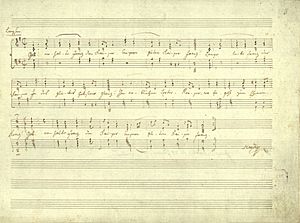
Haydn's work was key to developing what is called sonata form. However, his way of using it was a bit different from Mozart and Beethoven. Haydn especially liked the "monothematic exposition." This is where the music that introduces the main key is similar or even the same as the opening tune.
Haydn was also very creative with musical forms. He brought the fugue (a type of musical chase) into the classical style. He also made the rondo form (where a main theme keeps returning) more organized. Haydn was also the main person to use the double variation form. In this, he would vary two different themes that often were major and minor versions of each other.
More than almost any other composer, Haydn's music is known for its humor. Much of his music was written to please and entertain a prince, so it often sounds cheerful and upbeat.
Haydn's Musical Style
If you look at Haydn's music over the six decades he composed (from about 1749 to 1802), you can see it slowly but steadily became more complex and musically advanced. He learned from his own experiences and from other musicians. Several important changes happened in Haydn's musical style.
In the late 1760s and early 1770s, Haydn entered a period called "Sturm und Drang" ("storm and stress"). This name comes from a literary movement of the same time, though the musical changes actually happened a few years earlier. The music from this period sounds similar to his earlier work, but it is much more expressive, especially in pieces written in minor keys. These works are described as "longer, more passionate, and more daring." Some famous pieces from this time include the "Trauer" (Mourning) Symphony No. 44, "Farewell" Symphony No. 45, and the six "Sun" Quartets Op. 20. Around this time, Haydn also became interested in writing fugues in the old Baroque style. Three of the Op. 20 quartets even end with a fugue.
After the intense "Sturm und Drang" period, Haydn returned to a lighter, more openly entertaining style. These changes are often linked to a big shift in Haydn's job duties. He moved away from "pure" instrumental music and focused more on creating comic operas.
In 1779, an important change in Haydn's contract allowed him to publish his music without getting permission from his employer first. This might have encouraged Haydn to focus again on writing "pure" instrumental music. This change was most clearly seen in 1781 when Haydn published the six Op. 33 String Quartets.
In the 1790s, inspired by his trips to England, Haydn developed what is called his "popular style." This was a way of composing that, with great success, created music that was very appealing to many people but still had a smart and strong musical structure. An important part of this popular style was using folk tunes or folk-like melodies often. Haydn carefully placed these tunes in certain parts of his music, like at the end of sections or at the beginning of finales. In these places, the folk music helped to make the larger musical structure feel stable and grounded. Haydn's popular style can be heard in almost all of his later works, including the twelve "London" symphonies, his later quartets and piano trios, and his two late oratorios.
His return to Vienna in 1795 marked the last big change in Haydn's career. While his musical style didn't change much, his goals as a composer did. When he was a servant and later a busy businessman, Haydn wrote his works quickly and in large numbers, often with tight deadlines. As a rich man, Haydn now felt he could take his time and write for future generations. This is shown in the subjects of The Creation (1798) and The Seasons (1801).
This change in Haydn's approach was very important in the history of classical music. Other composers soon followed his example. Notably, Beethoven adopted the practice of taking his time and aiming for great achievements.
Instruments Haydn Used
A special piano called a "Anton Walter in Wien" fortepiano that Haydn used is now on display at the Haydn-Haus in Eisenstadt. In Vienna in 1788, Haydn bought himself a fortepiano made by Wenzel Schantz. When he visited London for the first time, an English piano maker, John Broadwood, gave him a concert grand piano.
Images for kids
-
Haydn as painted by John Hoppner in England in 1791.
-
Laus Deo ("praise be to God") written at the end of a Haydn music sheet.
See also
 In Spanish: Joseph Haydn para niños
In Spanish: Joseph Haydn para niños



